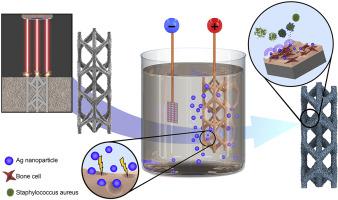Materials Today Bio ( IF 8.2 ) Pub Date : 2020-06-03 , DOI: 10.1016/j.mtbio.2020.100060 I A J van Hengel 1 , F S A Gelderman 1 , S Athanasiadis 1 , M Minneboo 1 , H Weinans 1, 2 , A C Fluit 3 , B C J van der Eerden 4 , L E Fratila-Apachitei 1 , I Apachitei 1 , A A Zadpoor 1

|
The holy grail of orthopedic implant design is to ward off both aseptic and septic loosening for long enough that the implant outlives the patient. Questing this holy grail is feasible only if orthopedic biomaterials possess a long list of functionalities that enable them to discharge the onerous task of permanently replacing the native bone tissue. Here, we present a rationally designed and additive manufacturing (AM) topologically ordered porous metallic biomaterial that is made from Ti-6Al-4V using selective laser melting and packs most (if not all) of the required functionalities into a single implant. In addition to presenting a fully interconnected porous structure and form-freedom that enables realization of patient-specific implants, the biomaterials developed here were biofunctionalized using plasma electrolytic oxidation to locally release both osteogenic (i.e. strontium) and antibacterial (i.e. silver ions) agents. The same single-step biofunctionalization process also incorporated hydroxyapatite into the surface of the implants. Our measurements verified the continued release of both types of active agents up to 28 days. Assessment of the antibacterial activity in vitro and in an ex vivo murine model demonstrated extraordinarily high levels of bactericidal effects against a highly virulent and multidrug-resistant Staphylococcus aureus strain (i.e. USA300) with total eradication of both planktonic and adherent bacteria. This strong antibacterial behavior was combined with a significantly enhanced osteogenic behavior, as evidenced by significantly higher levels of alkaline phosphatase (ALP) activity compared with non-biofunctionalized implants. Finally, we discovered synergistic antibacterial behavior between strontium and silver ions, meaning that 4–32 folds lower concentrations of silver ions were required to achieve growth inhibition and total killing of bacteria. The functionality-packed biomaterial presented here demonstrates a unique combination of functionalities that make it an advanced prototype of future orthopedic biomaterials where implants will outlive patients.
中文翻译:

功能丰富的增材制造的多孔钛植入物。
骨科植入物设计的圣杯是要防止无菌和化脓性松动的时间足够长,以使植入物能在患者体内存活。仅当整形外科生物材料具有一长串功能性使其能够完成永久替换天然骨组织的繁重任务时,才可以寻求这一圣杯。在这里,我们介绍了一种合理设计和增材制造(AM)拓扑有序的多孔金属生物材料,该材料由Ti-6Al-4V通过选择性激光熔化制成,并将大多数(如果不是全部)所需功能包装到单个植入物中。除了提供完全相互连接的多孔结构和形状自由度以实现针对患者的植入物之外,此处开发的生物材料已通过等离子体电解氧化进行了生物功能化,以局部释放成骨剂(即锶)和抗菌剂(即银离子)。相同的一步生物功能化过程也将羟基磷灰石掺入到植入物的表面。我们的测量证实了两种类型的活性剂持续释放长达28天。抗菌活性评估体外和离体小鼠模型显示了对高毒力和多药耐药性金黄色葡萄球菌的极高水平的杀菌作用完全消除浮游细菌和附着细菌的菌株(即USA300)。与非生物功能化植入物相比,碱性磷酸酶(ALP)活性明显更高,证明了这种强大的抗菌性能与显着增强的成骨性能相结合。最后,我们发现锶和银离子之间具有协同抗菌作用,这意味着需要低4–32倍的银离子浓度才能达到抑制生长和完全杀死细菌的目的。此处介绍的功能丰富的生物材料展示了功能的独特组合,使其成为未来整形外科生物材料的高级原型,其中植入物将使患者的寿命更长。



























 京公网安备 11010802027423号
京公网安备 11010802027423号